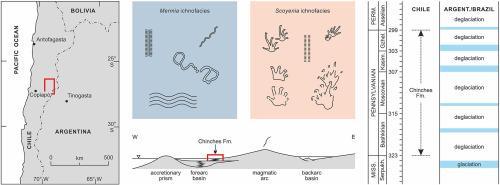来自Chinches组(安第斯山脉,智利北部)的四足动物足迹和其他化石:宾夕法尼亚时代和冰川影响的指示
IF 1.5
4区 地球科学
Q3 GEOSCIENCES, MULTIDISCIPLINARY
引用次数: 0
摘要
Chinches组是一个厚达3000米的古生代沉积层,在智利北部阿塔卡马沙漠南部边缘孤立的高山地区出现,研究很少。在最近一次对该地层各种露头的科学考察中,发现了大量的微量化石,为研究含化石沉积层的地层年龄和沉积环境提供了新的见解。Chinches组记录的鱼动物群包括无脊椎动物(Cochlichnus、Diplichnites、Glaciichnium、Vagorichnus)和脊椎动物(Undichna、Dimetropus、Dromopus、Limnopus、Matthewichnus),涉及环节动物、节肢动物、鱼类和四足动物的运动和摄食活动。该组合结合了斯科耶尼亚和梅尔米亚相的元素,表明河流-湖泊沉积条件,尽管不能排除部分层序受到海洋影响。尤其是非四足动物化石,与典型的晚古生代冰川湖相冈瓦纳区鱼动物群有相似之处。根据混合两栖动物和早期羊膜动物的四足类鱼动物群,提出了晚石炭世(宾夕法尼亚世)Chinches组的时代。该研究区发现了现今南半球唯一的石炭纪四足动物足迹,并提供了证据,证明热带和中南部纬度的宾夕法尼亚陆地脊椎动物群基本相似,包括temnospondyls, lepospondyls,早期突触类和类lacertods类蜥脚类。Chinches组对于研究晚古生代冰期对高海拔地区大陆甚至浅海生态系统的影响具有很大的潜力。本文章由计算机程序翻译,如有差异,请以英文原文为准。

Tetrapod tracks and other trace fossils from the Chinches Formation (Andean Precordillera, northern Chile): Indication for Pennsylvanian age and glacial influence
The Chinches Formation is an up to 3000 m thick succession of poorly studied Paleozoic sedimentary deposits cropping out in isolated high mountain areas on the southern edge of the Atacama Desert, northern Chile. During a recent scientific expedition to various outcrops of the formation, an abundant array of trace fossils was discovered that provides new insight into the stratigraphic age and depositional environment of the fossil-bearing sedimentary deposits. The recorded ichnofauna of the Chinches Formation includes invertebrate traces (Cochlichnus, Diplichnites, Glaciichnium, Vagorichnus) and vertebrate traces (Undichna, Dimetropus, Dromopus, Limnopus, Matthewichnus) referred to locomotion and feeding activity of annelids, arthropods, fish and tetrapods. The assemblage combines elements of the Scoyenia and Mermia ichnofacies suggesting fluvio-lacustrine depositional conditions, though a marine influence cannot be ruled out for parts of the sequence. Especially the non-tetrapod trace fossils show similarities with typical glacio-lacustrine late Paleozoic Gondwanan ichnofaunas. Based on the mixed amphibian-early amniote tetrapod ichnofauna, a late Carboniferous (Pennsylvanian) age of the Chinches Formation is proposed. The study area yields the only occurrence of Carboniferous tetrapod tracks in the present-day southern hemisphere and gives evidence that Pennsylvanian land vertebrate faunas of the tropics and mid-southern latitudes were basically similar by comprising temnospondyls, lepospondyls, early synapsids and lacertoid-like sauropsids. The Chinches Formation has great potential to study the effect of the Late Paleozoic Ice Age on continental and maybe shallow marine ecosystems in higher paleolatitudes.
求助全文
通过发布文献求助,成功后即可免费获取论文全文。
去求助
来源期刊

Journal of South American Earth Sciences
地学-地球科学综合
CiteScore
3.70
自引率
22.20%
发文量
364
审稿时长
6-12 weeks
期刊介绍:
Papers must have a regional appeal and should present work of more than local significance. Research papers dealing with the regional geology of South American cratons and mobile belts, within the following research fields:
-Economic geology, metallogenesis and hydrocarbon genesis and reservoirs.
-Geophysics, geochemistry, volcanology, igneous and metamorphic petrology.
-Tectonics, neo- and seismotectonics and geodynamic modeling.
-Geomorphology, geological hazards, environmental geology, climate change in America and Antarctica, and soil research.
-Stratigraphy, sedimentology, structure and basin evolution.
-Paleontology, paleoecology, paleoclimatology and Quaternary geology.
New developments in already established regional projects and new initiatives dealing with the geology of the continent will be summarized and presented on a regular basis. Short notes, discussions, book reviews and conference and workshop reports will also be included when relevant.
 求助内容:
求助内容: 应助结果提醒方式:
应助结果提醒方式:


